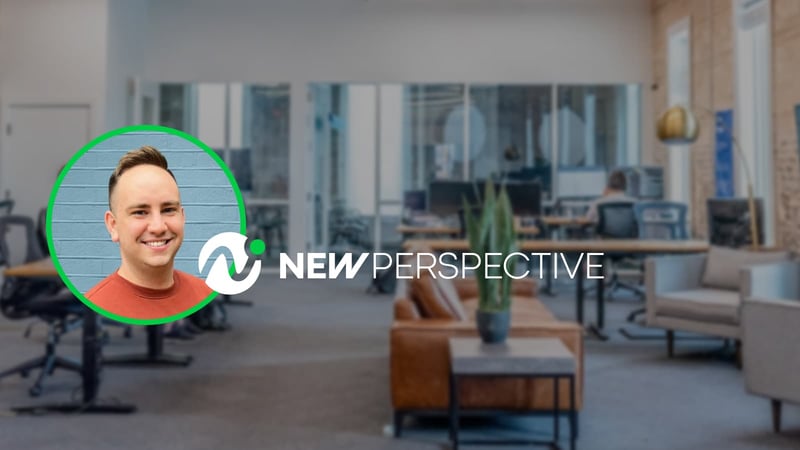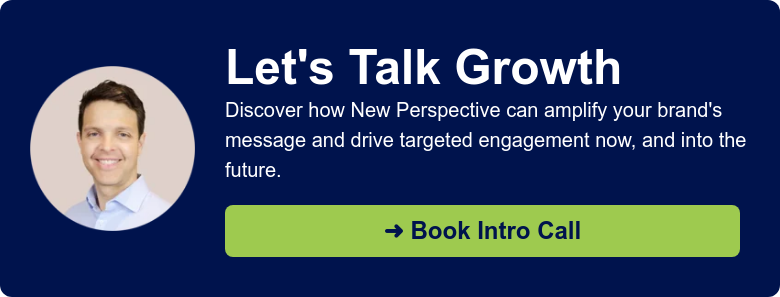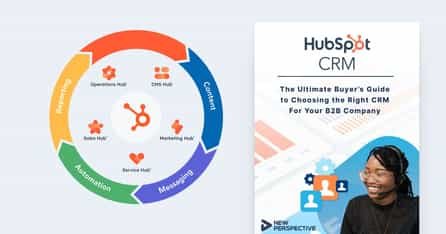Choosing a Marketing Agency: CSM Insider Tips for Success

Dan Berghaus, Senior Customer Success Manager for New Perspective, sat down with Jana Martin to talk about clients and marketing agencies, including how clients can find the agency that’s the best fit. Here are highlights from their conversation:
Agency-client partnership
Jana Martin: Let’s talk about what clients want in a good relationship with their marketing agency. What’s most important?
Dan Berghaus: In the best client relationships we’re treating each other like team members – it’s a real partnership. That synergy sets everyone up for success. I do think most clients are looking for that kind of partnership. The trust starts to build when a client sees deliverables they're pleased with, and results come in they weren't expecting. But clients always need to know that their agency has their back.
JM: How do clients know if an agency is the right fit?
DB: Find an agency you are genuinely excited to work with. Maybe you kicked things off with a great conversation, or during the sales process felt instant synergy and trust — those are signs it could be a great partnership. Also, make sure what you're looking for is within their core competencies: if your industry relies on print work, don't go to a digital marketing agency.
JM: How important is it to find an agency with experience in your industry?
DB: It’s more important to have an agency that gets your needs, but if it shares your passion that’s great. New Perspective is passionate about sustainability and cleantech, and we work really well with clients focused on sustainability, but that’s certainly not the only industry we work with. The past year I’ve watched our team work with new industries and do really well.
JM: If you're a startup, should you look for a small or a large agency?
DB: I would look at smaller digital marketing firm. If you're a startup going to a much larger agency with 30, 40, 50 plus team members, they have much larger clients. There's a chance you could get lost in the mix. Ensure an agency treats you as a partner and can prioritize your work even if you don't have the biggest budget, the longest history or the most funding secured.
JM: What doesn't make a good partnership between a client and an agency?
DB: When the client / agency relationship feels transactional, it’s harder to get to know each other or align on a common goal. If either party can't fully commit to what needs to happen for a successful partnership, things aren't going to work.
From an agency’s point of view, if the client misses scheduled meetings or shows up late, or can’t make time to review deliverables the agency puts together, for instance, that’s not a good sign. From a client’s point of view, one thing to look out for is whether you can just pick up the phone and have a quick conversation with your agency’s point of contact. If you don’t feel a sense of mutual trust and respect, you may not be with the right agency.
JM: What should clients understand about their role?
DB: A client needs to be just as invested as their agency. The less successful clients are the ones who give us initial direction and then disappear for months. Especially when we’re onboarding with them, we rely on them for industry expertise. We can’t call ourselves their industry or brand expert right off the bat: we need them to help bring us up to speed. Once we are, we can take things and run with them, but we still need long-term collaboration.
Our process and client onboarding
JM: How do you structure the process?
DB: When we first onboard with a new client, there are one to two months full of meetings trying to understand every tiny piece — their brand's history, key audiences, products, and how it all works. We’re talking almost every day, whether on the phone or Zoom or through digital communication. There may be a number of different team members involved as well as the CSM.
Then we pivot to weekly or biweekly meetings, usually with the CSM. At that point there's a lot happening in the background, and we use those regular touch points to provide updates and progress reports and make sure we’re both moving towards delivery dates. But communication should be open: if you need to shoot an email to your CSM or get them on the phone, do. Any of the CSMs here are happy to talk with their clients about what's going on.
A lot of clients like to see a game plan so they know the goals they've identified for their business are actively being worked. I also like to curate a wish list of things clients talk about wanting to tackle at some point, so we can prioritize them going forward. With some clients we’re working on a quarterly cadence, others yearly, but there’s bound to be fluctuation month to month as last-minute items pop up.
JM: What role does communication between client and agency play in terms of planning?
DB: Communication is really important — especially when it comes to planning. If clients and agencies have good rapport and there’s mutual respect and trust, it’s easy to have candid conversations on the need to shift direction to some new priority or action item.
On our end, if we're facing some type of unforeseen delay, we let a client know quickly. We want the same thing from clients. If a client has a big event coming up that will take away all their resources for a month, we need to know. When we're planning future work together, we can plan out items for that period that we can do independently, so the client’s focus, in this case, can be devoted to their upcoming event.
Ask questions so you're confident your marketing agency’s using the right channels and talking to the right audiences. You need to understand what the agency’s doing on your behalf. A lot of times clients have their own understanding of a marketing objective, and it’s only by having conversations that we find a better route than what they originally assumed.
JM: Do you think it can be hard for clients to see this process as a long game?
DB: It's important for the agency to let clients know when they should start seeing results. Things like SEO or results for paid ad campaigns really progress and build over time. It might take a month to finalize ad copy for a Google ad campaign and another few weeks to determine what audiences we want to be hitting. Then those ads need to run for a month or two before we can get baseline metrics and understand what audiences are engaging with. If this mindset is set up front, then hopefully, clients are more comfortable with the process being a long game.
JM: What's the best way to make sure that all the stakeholders are working together?
DB: There’s a saying — death by committee. It's not that we don't want everybody's opinion or expertise. But once you start doing that, you really open yourselves up to aiming for perfection rather than progress. Then things tend to not happen as quickly. Make one person the liaison between client and agency, the one who collects feedback from their side, relays it back and has the authority to give approvals. Having a designated driver really helps move things along and keeps communication and expectations clear.
Expectations and etiquette
JM: Let’s talk about expectations over time. What do you want clients to know?
DB: Realize there are short-term, long-term, and flexible goals being met all at once. When we plan out scopes, I like to have some short-term items, like a design deliverable, where clients can see an immediate result for their investment. But there are always long-term items going on that the rest of the agency’s team is working on, whether it’s optimizing ad campaigns or doing a boatload of technical updates to a website. The client may not see those, but they’re critical for success. There are also going to be times we need to adjust, such as a big industry update that’s rippled the scene — we need to be able to shift fast to address it. But if we’re always having to do pivots or updates, and you’re always rescoping, that can derail progress.
JM: What are your thoughts in terms of meetings and feedback?
DB: Show up to scheduled calls — they’re so important for client progression. Take that time (whether it's 30 or 60 minutes every week), to look at a deliverable and give real-time feedback so we’re all working from the same page. If for some reason you can’t make the call — maybe you’re tied up with your own deliverables, then delegate another member of your team. Those calls aren’t just about a singular action. We’ll look at metrics from past campaigns and pull out key themes that help inform decisions on new strategies for the next round of campaigns.
JM: What platforms are really good for staying in touch?
DB: Basecamp, which you can use just like email. It appears in your inbox, but you can set up individual to-do’s that translate into deliverables or action items the agency is completing on behalf of the client. A client at any point in time can go look in Basecamp and see exactly what the agency is working on. They get real time updates without needing to have a conversation. We do show clients how to use Basecamp so they get comfortable navigating it.
JM: Have any insider tips for clients on getting the best work out of a marketing agency?
DB: Give us feedback, and if you’re expecting revisions, help us understand why you don’t like something. Realize we can only move as fast as you allow us to, and that we don't know everything you know. Don’t say yes just to say yes, and don’t give us information that isn’t right just to move the conversation forward. If you’re not sure of something, it’s so much better to take the time to check with your team.
Once you've onboarded with us, the work doesn’t stop there. Participate in all the strategy workshops we take you through — understanding your target audience, creating buyer personas, crafting messaging, and understanding how your products meet the needs of your ideal customer. Come in with an open mind, because some of our questions might make you look at your business and audiences in ways you never have. No matter how established your company or expertise, you need to be willing to change the way you see things.
Also, this has to do with requests I’ll get a lot: there are some requests that may seem simple enough, but they can really slow down the overall timeline. I call these “can you just” requests — where a client may think it will just take 15 minutes or so to address, but it won’t. There’s a whole queue of scoped work that needs to be done ahead of that new request, so it could take three days before I can actually get it met. Or it could actually take a few hours and take resources away from the overall deliverables and timeline. If I notice a client has a lot of those requests, ’ll adjust for the next quarter so we can bake in more flexible hours.
How to work with your Customer Success Manager
JM: What do you wish clients understood more about the role of a CSM?
DB: The role of a CSM is to be a communicator between agency and client. They maintain the project timelines and have conversations with the internal team to make sure that the client's goals are being met. But we can’t answer everything. If a client has a question related to specifics, like key metrics or technical components, it’s the CSM that gathers information from the agency’s subject matter experts, and that can take a day or two. They also know everything the client likes and doesn't like in messaging, branding and design, and they help convey that back to the agency’s team. CSMs are go-betweens, but they’re also your allies.
Want to know more about how New Perspective and our clients achieve success? Reach out to one of our inbound marketing experts for insider secrets for digital marketing strategy success. :)




